|
Table of Contents |
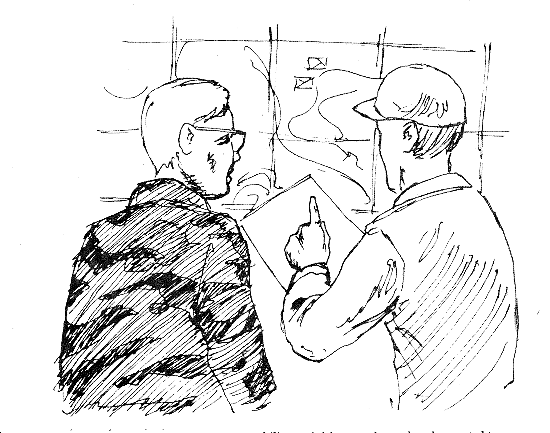
Countermobility activities are planned and executed to defeat the enemy's ability to maneuver. This chapter addresses the coordinated development of obstacle plans at various levels of responsibility. Procedures for positive control of reserve obstacles and preparation of demolition orders are also included.
An effective command and control system is a must for countermobility activities. The primary goal is to make the enemy go where we want, when we want, at speeds we dictate. We want to accomplish that goal with little or no effect on the ability of friendly forces to move and maneuver. To do so requires a command and control system that emphasizes long-range planning, centralized control, and decentralized execution. Centralized control is necessary in the planning of countermobility activities to insure that the obstacle plan is integrated with and supports the overall tactical plan. Senior command levels must dictate obstacle zones, obstacle-free areas, and reserve obstacles in the planning process. The specific type and placement of those ground obstacles are best accomplished by the level that can actually conduct a ground reconnaissance.
Centralized control of countermobility activities normally begins at the corps level with the corps obstacle plan. The corps obstacle plan is general in nature and concerned with the employment of obstacles as a part of a specific tactical operation. The obstacle plan supports the corps commander's concept of the operation and integrates the terrain aspects of the operation with the tactical plan. Through the allocation of engineer support and logistics, the corps commander shapes the countermobility efforts of the division by weighting those areas viewed as most critical. The corps obstacle plan provides a framework for the division plans. The corps obstacle plan can and will normally include the following items:
|
PREPARED BY: Corps HQ SCOPE: Comprehensive, coordinated plan which includes: 1 Responsibilities 2 General locations of unspecified obstacles 3 Specific obstacles 4 Special instructions, limitations, coordination, completion times BASED ON: Guidance from higher HQ, tactical plan, maps,
aerial |
The corps obstacle plan is a command and control means for the corps commander to communicate the countermobility concept to subordinates. Corps obstacle plans must be provided to the Army Battlefield Coordination Element (BCE) which is the land forces coordinating agency with the Air Force Tactical Air Control Center (TACC). This coordinating and sharing of information is accomplished for several reasons:
The corps plan/order is received at division and analyzed for specified and implied tasks. Once this is accomplished, the division obstacle plan is developed in two stages, initial and final.
An initial plan, based on the corps obstacle plan, division tactical plan, fire plans, maps, terrain analysis, and reconnaissance, is disseminated to the brigades and other subordinate units as quickly as possible to allow time for obstacle selection on the ground. This must be done in conjunction with selecting fighting positions and locating weapons systems. The initial plan will include an overlay showing, as a minimum, targets directed by corps or higher headquarters and obstacles of such importance as to be specified by division. The plan may also specify obstacle zones to be developed by designated unit(s). In addition, the plan will assign responsibilities and, where necessary, priorities; allocate obstacle materials to include scatterable mines; and generally include as much of the information described for the corps plan in whatever available detail as appropriate.
|
PREPARED BY: Division HQ INITIAL SCOPE: 1 Concept and detailed guidance 2 Specific obstacles directed by corps or division,
responsibilities, BASED ON: Corps obstacle plan, division tactical plan,
fire plans, FINAL SCOPE: Completes the cycle. Specifically identifies
each 1 Target type 2 Target number 3 Coordinates 4 Priority 5 Completion date/time 6 Responsible unit 7 Special instructions (execution times/authority) UPDATE BASED ON: Brigade plans and input from other
units |
After the brigades develop their obstacle plans in detail, and other units develop assigned portions of the division obstacle plan by selecting individual obstacles, these subordinate plans are then incorporated by division with the initial plan to produce the final plan. The plan will normally be issued as an annex to the division operations order.
When time is extremely limited, the division plan may never develop beyond the initial concept plan. Conversely, when adequate time is available, the division plan will be submitted to corps and may be incorporated into a republished corps obstacle plan. The complete division obstacle plan should hot be carried forward of division headquarters because of the danger of compromise. Division provides each brigade with extracts of the detailed plan to include pertinent portions of the plans of adjacent brigades.
Brigades and comparable units develop a detailed obstacle plan, within the guidance provided by division, based on their tactical plans and detailed terrain reconnaissance. To be effective, obstacle plans must be integrated at maneuver unit level. This process is described in chapter 4. If combat is imminent, preparation of obstacles begins immediately without waiting for approval of the obstacle plan. Obstacle construction and obstacle plan development continue con-currently. Final brigade obstacle plans include:
Reserve obstacles (non-nuclear) are those obstacles or demolition targets the commander deems critical to the tactical plan. The authority to execute the obstacle is reserved by the authorizing commander through a formal order known as a demolition order. Reserve obstacles must be carefully selected. Their proper execution requires a manpower allocation that could be used elsewhere if it is not required to guard and execute a reserve obstacle. If not executed timely and properly, reserve obstacles could be catastrophic to the tactical plan or operation. An excellent example of a failure to execute a reserve obstacle is the Remagen bridge in World War II.
|
As Allied Forces advanced to the vicinity of the Rhine River in early March 1945, the Germans made preparations to demolish all bridges across that wide river. The German high command planned to use the Rhine as a moat to afford their beleaguered forces a badly needed rest. Each time the Allies attempted to capture a Rhine River bridge, the Germans methodically and efficiently destroyed it. However, at one bridge--the Remagen railway bridge--a confused situation was ripe for disaster. The German bridge garrison at Remagen consisted of an understrength infantry company, a handful of engineers, and a smattering of Volksturm or Home Guard units. These elements were under the command of Captain Bratge, the infantry company commander. The engineers were commanded by Captain Friesenhan. Neither Captain Bratge nor Captain Friesenhan had specific instructions concerning the demolition of the bridge. The engineer commander had standing orders to execute the obstacle only upon the written order of the tactical commander (Captain Bratge). At dawn on 7 March 1946, a steady stream of disorganized German units and stragglers were fleeing l cross the bridge. These soldiers brought stories of large American forces approaching rapidly from the west. Alarmed, Captain Bratge attempted to contact higher headquarters for instructions. He was only able to reach a duty officer at Army Group B who assured him that headquarters was not concerned about the situation at Remagen. At 1115 hours, Captain Bratge was approached by a German officer who identified himself as Major Scheller. Major Scheller stated that he had been sent by the commander of LXVII Corps to assume command at Remagen. The Corps was holding a bridge-head on the west bank of the Rhine, but the perimeter was rapidly being forced toward Remagen. Once Captain Bratge had assured himself of Major Scheller's identity, he gladly relinquished command. Unfortunately, the vehicle containing Major Scheller's radio had become lost enroute to Remagen; thus, he had no means of communication with higher headquarters and no specific instructions. Soon after 1300 hours on 7 March 1945, Major Scheller received reports that American forces had reached the bluffs over-looking the Remagen bridge. Major Scheller was reluctant to destroy the bridge because a German artillery captain insisted his battalion and its guns were going to cross the bridge shortly. Captain Friesenhan crossed to the west end of the bridge. He planned to execute a crater which had been emplaced some months before to prevent tanks from rapidly reaching the bridge. Around 1600 hours. a company of American infantry and tanks appeared at the approaches to the bridge. On his own authority, Captain Friesenhan fired the crater, then raced across the bridge to find Captain Bratge and Major Scheller to get the order to blow the bridge. Enroute, he was knocked senseless by a concussion from a tank shell. Fifteen minutes passed before he regained consciousness, continued across the bridge, and obtained approval to fire the demolition. Initially, Captain Friesenhan insisted on written orders, but then relented in the interest of time. Captain Friesenhan turned the key to electrically fire the charge, but nothing happened. He tried again and again with no results. He realized that the firing circuit was broken. By this time, American machine gun fire and tank fire were sweeping the bridge. Repairs to the circuit were out of the question. A sergeant volunteered to go out on the bridge and fire an emergency charge nonelectrically. The sergeant dashed out on the bridge, and returned on the run minutes later. The charges exploded, but when the dust settled, the bridge still stood. American First Lieutenant Karl H. Timmerman, commander of A Company, 27th Armored Infantry Battalion, and his soldiers rushed across the bridge. They established the beginnings of a bridgehead which would enable US forces to transport 8,000 soldiers, including one tank battalion, across the Rhine in the next 24 hours. Captain Friesenhan and Captain Bratge were captured. Major Scheller and three other officers were tried by a German military tribunal, and were executed by a firing squad. |
Some obviously glaring errors which proved extremely costly to the German Army included:
A reserve obstacle must have positive written information and instruction on the following items:
There are three primary players involved in the proper and timely execution of reserve obstacles; namely, the authorizing commander, the demolition guard commander, and the demolition firing party commander.
The authorizing commander has overall responsibility. The authorizing commander may be a corps, division, brigade, or any other commander who deems that a particular target or obstacle is so critical to the tactical plan that its preparation, protection, and execution upon order are insured.
The demolition guard commander is the onsite commander who takes orders from the authorizing commander and who is responsible for the successful execution of the reserve obstacle. The demolition guard commander is also responsible for security, preparing the obstacle, and giving the order to arm and execute the obstacle once the authority to execute has been received.
The demolition firing party commander receives orders from the demolition guard commander and is in technical charge of the preparation and firing of the reserve obstacle. The demolition firing party is normally comprised of engineers.
The demolition guard and the demolition firing party can, in some circumstances, be one and the same. The demolition guard must be of sufficient strength and size to protect the obstacle and prevent enemy capture prior to execution. Both the demolition guard and demolition firing party must keep the target in sight at all times. Positive communications must be maintained between the demolition guard commander, the firing party commander, and the authorizing commander.
|
|
|
|
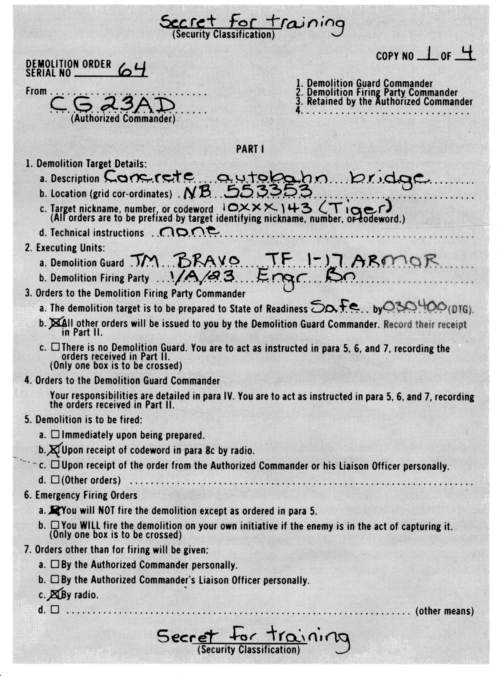
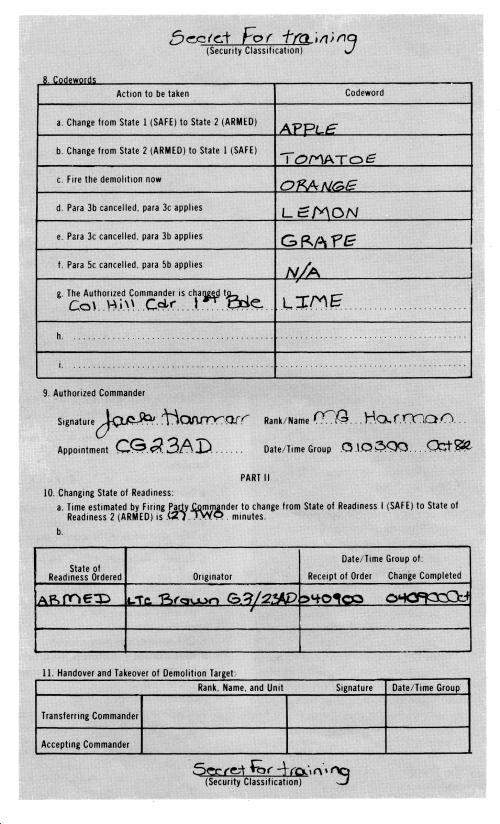
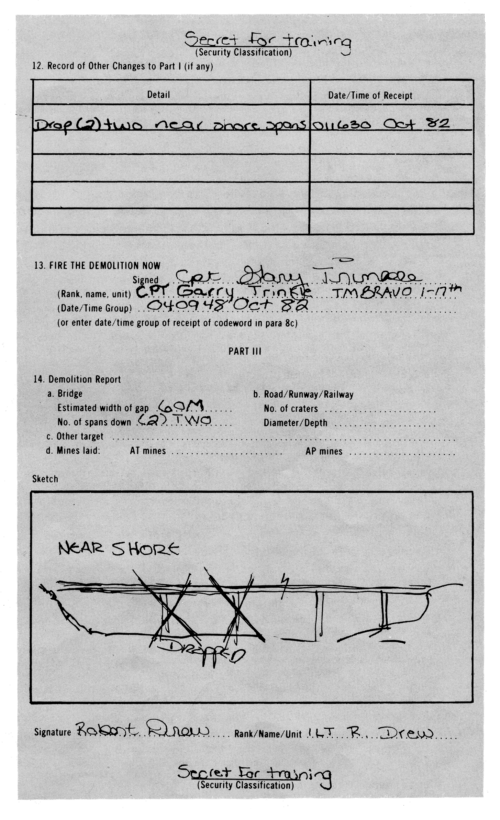
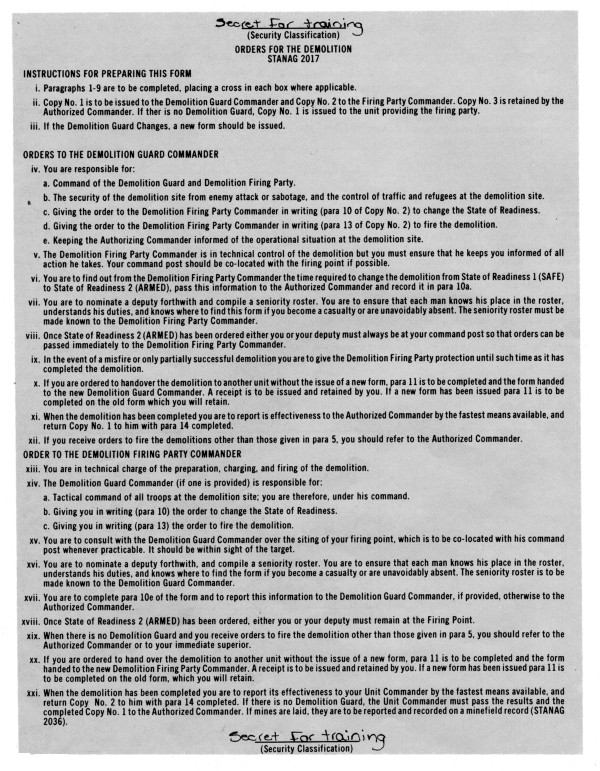
The obstacle plans and updates are the principal command and control vehicles for obstacles planned and emplaced before the battle begins and during its early stages, Further employment of obstacles will be based on enemy movement and designed to fit a particular tactical situation. Responsive communication, timely intelligence, and rapid decision making are keys to successful obstacle employment after the battle has begun.
Reserve obstacles can be vital to an operation. They must be planned and executed carefully. The number of reserve obstacles should be held to the absolute minumum due to the assets required to insure that they are guarded and executed properly.